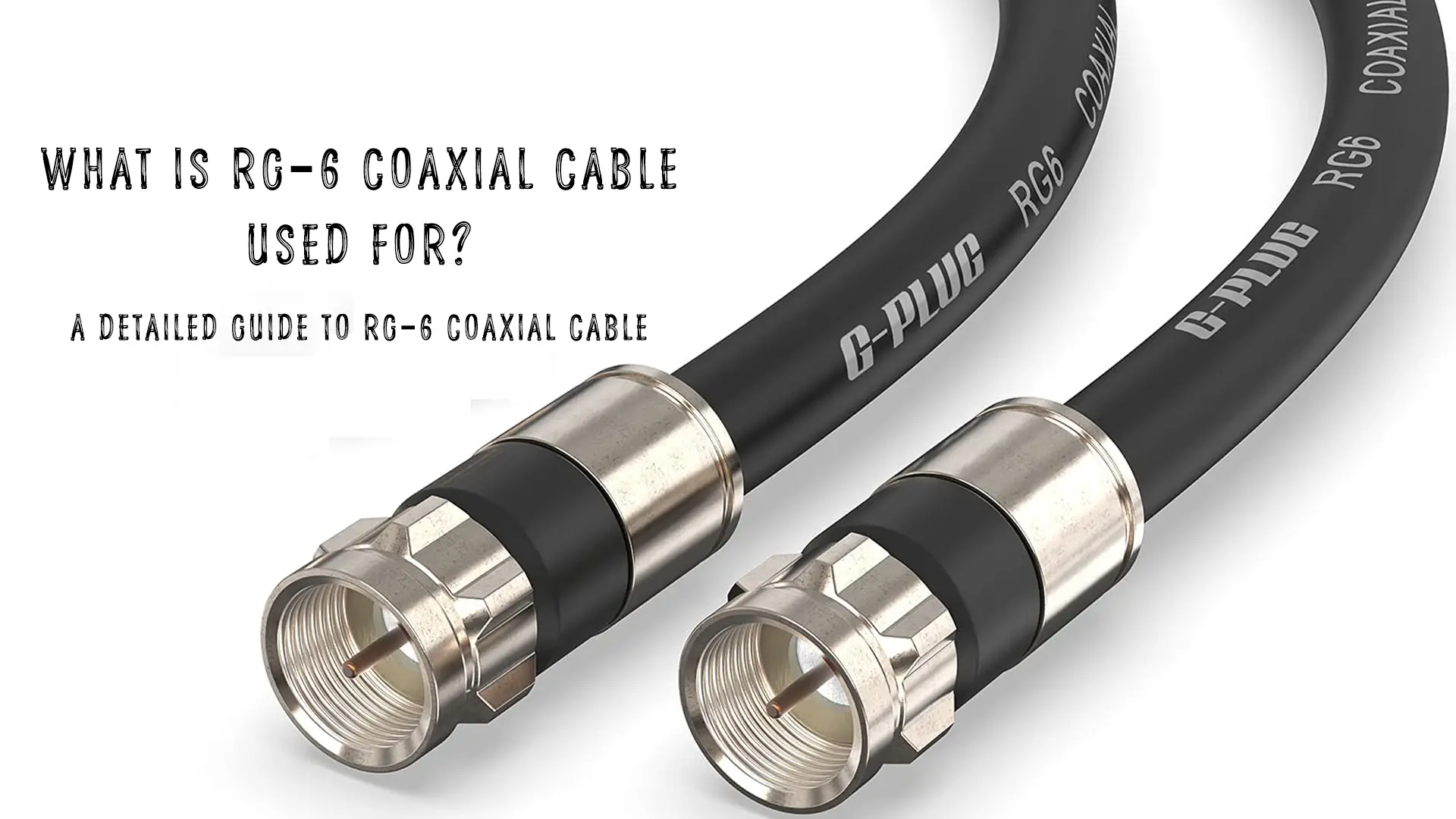Coaxial cables are widely used in home installations to transfer TV and internet signals, and one of the most commonly used cables for this kind of installation is the RG6 coaxial cable.
In other words, if you have existing coaxial wiring in your home, the chances are that an RG6 cable is used there.
However, if you just heard of this cable, RG6 might sound like a bunch of random letters and numbers that leave with more questions than answers.
In this guide, we will try to answer some of the questions you might have and help you understand the essentials regarding RG6 cables. You will learn whether they are a good fit for your use case or not, and how to choose a good RG6 coax.
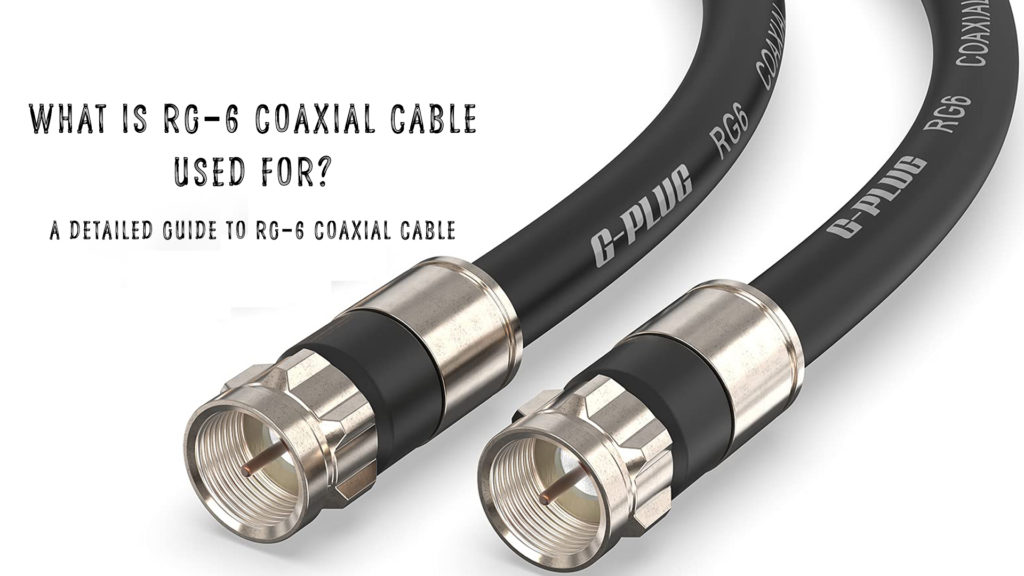
CONTENTS
- What is RG6 Coaxial Cable, and What’s It Used For?
- Is RG6 Better Than Other 75-Ohm Coaxial Cables?
- RG6 vs. RG59
- RG6 vs. RG11
- Can I Mix RG6 Coax With RG11 and RG59?
- What’s the Meaning of “RG” In RG6?
- What’s the Difference Between RG6, RG6A, RG6/U, RG6Q
- RG6 vs RG6 Riser (CMR) vs RG6 Plenum (CMP)
- Is RG6 Coax Good for OTA and Satellite TV Antennas?
- How Far Can I Run RG6 Coaxial Cable?
- Dual Shielded vs. Triple Shielded vs. Quad Shielded RG6 Coax
- What to Look For When Buying An RG6 Coaxial Cable?
- What are the Best RG6 Coaxial Cables To Buy Right Now?
- 1. Best RG6 Coax Cable For Gaming and Streaming – Ultra Clarity Coax Cable
- 2. Best RG6 Coax For Regular Home Use – PHAT SATELLITE INTL
- 3. Best RG6 Coax Rated For Outdoor Use – CIMPLE CO Coax Cable
- FAQ
What is RG6 Coaxial Cable, and What’s It Used For?
RG6 coaxial cable is widely used in home installations for transferring TV and internet signals.
One of the main characteristics of RG6 coax is its nominal impedance of 75 ohms. This makes it a perfect fit for home installations to transfer TV signals. It is used for cable and satellite TV installations and regular OTA (over the air) antennas.
Besides that, being a 75-ohm cable, RG6 can also carry internet signals.
Actually, it can carry both the internet and TV signals at the same time, and this is one of the reasons why using RG6 coax for home installations has become a kind of standard.
Why is RG6 Coax Good for Both – the Internet and TV?
The nominal impedance of 75 ohms and the operating frequency range of 1-3 GHz make RG6 coaxial cable suitable for both internet and TV signals.
All standard TV devices that connect to a coaxial outlet (like TVs, cable boxes, etc.) are designed to work with 75-ohm signals. Therefore, RG6 being a 75-ohm cable, perfectly fits these applications.
Theoretically, a 50-ohm cable would be a better fit when transferring the internet signal because it can work with higher frequencies. However, most existing internet devices like cable modems and MoCA adapters are designed to work with 75-ohm cables.
So, essentially, wherever you need a coax with an F-type connector in your home, whether it be for installing coax wiring throughout your entire home, connecting your cable modem, cable TV boxes, DVRs, satellite or OTA antennas, or similar, in all of these cases you can use RG6 75-ohm coaxial cable.
Is RG6 Better Than Other 75-Ohm Coaxial Cables?
RG6 coaxial cable is not the only 75-ohm RG-type coax that exists on the market. So, what makes it so special?
RG6, compared to other RG-type 75-ohm cables, has the most desirable set of features that make it perfect for home installations.
For example, compared to RG-59, another widely used RG-type coaxial cable which also has an impedance of 75 ohms, RG6 cable features a thicker conducting core, better insulation, and better shielding.
This means that, in general, RG6 coax will work better than RG59 when it comes to transferring TV and internet signals. Simply because the overall quality of RG6 coaxial cables is higher than of RG59, and the overall price difference is insignificant compared to the difference in quality.
RG11, RG12, RG34 are also 75-ohm coaxial cables. However, all of these are thicker and more expensive than RG6 coaxial cables. At the same time, using one of these instead of an RG6 coax would not give you a significant gain in the quality of the signal transfer for regular home usage.
Also, another reason why RG6 is considered the best choice for home installations is its thickness. RG6 is usually thicker than RG59 but thinner than RG11, RG12, and RG34. This makes it the most suitable for achieving high-quality signal transfers but still easy to handle and use for in-wall installations where thicker cables would be harder to handle.
RG6 vs. RG59
As mentioned above, both RG6 and RG59 coax cables have the same impedance of 75 ohms.
However, there are several differences between these two types of cables.
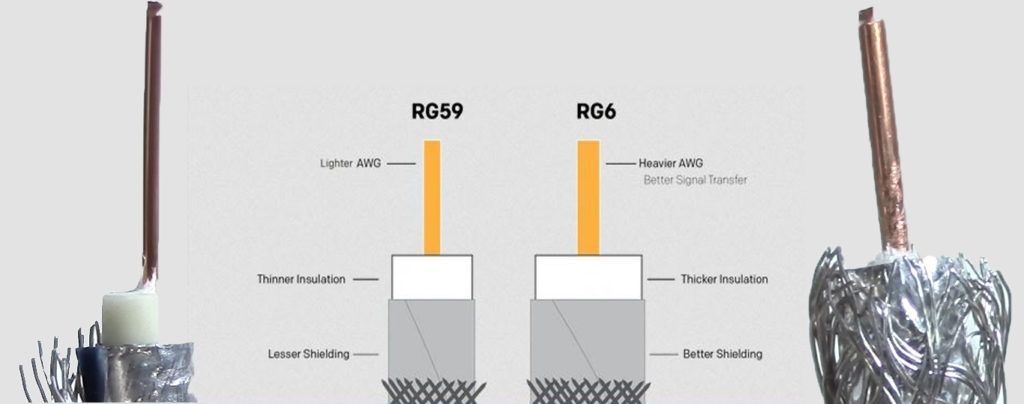
Image Source – Sewell
RG6 coax comes with a thicker conducting core. A regular RG6 cable will have an 18 AWG conducting core, while RG59 has a 20 AWG conducting core. (AWG stands for American Wire Gauge – a standard used to size cable conductors, the smaller the number, the thicker the conducting wire).
A thicker conducting core means better connectivity and higher bandwidth.
The shielding on RG59 cables is usually lower than on RG6 cables. This is because RG6 cables can have really dense shielding, often a couple of layers of aluminum foil and braided shielding stacked on top of each other.
The different ways these cables are built have an effect on their frequency range. For example, RG6 coaxial cables can operate well within the 1-3 (or in some cases up to 5) GHz frequency range but are not that great when used for frequencies lower than 1 GHz.
On the other hand, RG59 cables are better for lower frequency signals, especially below 50 MHz. So one of the rare use cases in your home installations where RG59 would perform better would be for the CCTV surveillance systems (HD Over Coax) and video projectors.
So, unless you need a cable for your CCTV surveillance system, RG6 cable should be a better choice for almost any other use case where a 75-ohm cable is required.
It is important to point out that RG59 coax was way more popular during the 1990s and was widely used for home installations. If your home is still wired with RG59 cables, you might want to consider changing it.
Because of their better shielding and thicker conducting core, RG6 cables will have way lover attenuation – signal losses over larger distances will be significantly lower compared to RG59 cables.
The Impact of Coaxial Cable on TV Reception – RG6 VS RG59
RG6 vs. RG11
RG11 is also a 75-ohm coaxial cable. However, there are a few differences between RG6 and RG11 worthy of mention.
RG11 is a thicker “cousin” of RG6 cable. The conducting core has a thickness of 14 AWG. Compared to RG6 cable, RG11 offers better signal transfer quality. RG11 is used in applications where the signal has to travel over very long distances. They are also often rated for outdoor use and usually can be buried in the ground.
However, if you don’t need to run a long cable (100 ft or more) or you don’t need to bury it in the ground, there’s little benefit in using an RG11 coax instead of RG6. And there are RG6 cables that are rated for outdoor use and ground burial anyways.
RG12 and RG34 are also 75-ohm cables, but they are almost completely out of use for anything that would fall under the regular home usage category.
The Impact of Coaxial Cable on TV Reception – RG6 VS RG11
Can I Mix RG6 Coax With RG11 and RG59?
RG59, RG6, and RG11 are the most commonly used 75-ohm RG-type coaxial cables. Since they all have the nominal impedance of 75 ohms, you could mix these as long as you are aware of the downsides of doing that.
For example, if you have an existing coax installation where RG59 coax is used, then adding an RG6 or RG11 coax to such installation would probably not work well if that wiring is used for devices that operate on frequencies lower than 50 MHz since RG6 and RG11 are designed to operate with frequencies above 1GHz and RG59 is more suitable for frequencies up to 50 MHz.
However, you could mix RG6 with RG11 as both of these coaxial cables operate on similar frequencies. In regular home installations, you would hardly see any significant change in performance in the case of mixing RG6 with RG11.
Also, given that RG11 is usually fully rated for outdoor use and works better when you need to have longer runs, there are still some practical situations where you might want to use this particular cable instead of RG6.
What’s the Meaning of “RG” In RG6?
When it comes to denominations and markings on coaxial cables, there’s a true little mess regarding that. However, we will keep the story short.
Essentially, RG was a military denomination used during and after WW2 to refer to a specific military standard regarding coaxial cables used for radios back then.
There are two ‘theories’ regarding what RG stands for. The most widespread theory is that RG stands for “Radio Guide”. The other theory claims R is for “radiofrequency” and G is for the “government”.
The mentioned military standard for coaxial cables is no longer valid. However, it remains in use by the manufacturers as a kind of an “unofficial” standard. This means that each manufacturer can interpret the specifications the way they want as there’s no official standard for RG-type coaxial cables.
So, there’s no standardized way to mark the exact quality of the cable. Despite the fact that most coaxial cable manufacturers will try to keep up with the “standard,” it can still happen that two different manufacturers produce cables of significantly different qualities with the same denominations and markings.
What does this mean for regular users who just want a good cable that will work as expected?
It basically means that you need to pay a little more attention to the quality of the braided metal shield and the quality of the main dielectric insulator around the conducting core. In other words, when judging the quality of a particular cable, you still need to look beyond the markings written on it.
What’s the Difference Between RG6, RG6A, RG6/U, RG6Q
Given that these denominations and markings are not standardized, they might vary, but all of these (RG6A, RG6/U, RG6Q) are just slightly different “flavors” of RG6 coaxial cable.
The “A” denomination usually means some kind of an upgrade to the regular version of the cable. For example, it could be that RG6A has a more flexible conducting core than RG6.
“U” usually stands for universal, multipurpose use.
On some RG6 cables, you will see the “Q” denomination (RG6Q). This usually means a quad shielded RG6 coax with two layers of aluminum foil and two layers of braided shielding.
RG6 vs RG6 Riser (CMR) vs RG6 Plenum (CMP)
You’ll also often notice that coaxial cables have the “R”, “Riser”, or “CMR” marking. This means that these are rated to be used in floor-to-floor installations. So, if you find an RG6 coax with one of these markings on it, you should know that these cables are suitable for use in risers and in-wall installations. Basically, a riser-rated cable is designed to behave better in case there’s a fire, having an improved PVC jacket that is more resistant to heat.
On the other hand, if you see a coax with a “P”, “Plenum” or “CMP” marking on it, this means that the cable is rated for plenum installations. They are even more resilient to fire and are designed to restrict flame propagation to less than five feet. These are also often used for installations that go through air ducts.
So, the main difference between a standard RG6 coax and RG6 Riser or RG6 Plenum coax is related to their resistance to fire.
A regular RG6 cable without a riser or plenum rating can still be used anywhere where a certain fire code doesn’t need to be followed. A regular RG6 cable will usually be less resilient to fire compared to a riser-rated (CMR) cable. However, a plenum-rated cable will be the best when it comes to being resilient to fire and is usually a bit more expensive than a regular or riser-rated cable.
Plenum and Riser Cables Explained
Is RG6 Coax Good for OTA and Satellite TV Antennas?
Over-the-air TV antennas usually work with frequencies from around 50-250 MHz for VHF signals and 470-960 MHz for UHF signals.
This means that if you’d be using an RG59 cable for OTA antennas, you would still get some decent performance. However, since the ideal operating frequency for RG59 cables is up to 50 MHz, you would, theoretically, still get similar results with RG6 coaxial cables because their ideal operating frequencies start above 1 GHz. But, given that RG6 cables have way better shielding than RG59, a good-shielded RG6 cable would still be a better choice in this case, for any runs longer than 50 feet.
When it comes to satellite TV antennas, most LNBs modulate satellite TV signals down to the 950-2150 MHz frequency range. So, even though satellite TV signals work on way higher frequencies, your LNB modulates them down to this intermediate frequency range that is easier to run through regular coaxial cables.
Since RG6 cables usually operate well within the 1-3 GHz frequency range, they are great for use with satellite TV antennas.
How Far Can I Run RG6 Coaxial Cable?
This primarily depends on the overall quality of the particular cable you want to use, and it depends on what it is used for. In other words, if you plan to run higher frequency signals through your coax (like satellite TV or internet), the signal loss over longer distances will be more noticeable unless you plan to use amplifiers.
It is important to know that every coaxial cable is affected by attenuation when it comes to having long runs of a coaxial cable.
Attenuation is basically a signal loss that occurs within the cable due to its physical specifications, and it’s closely related to the cable’s impedance and the frequency of the signal sent through it.

Another thing that can add to the signal losses in your coax wiring is splitters or any other devices where you need to cut the cable and use a connector. This is also known as “insertion loss”.
When used for satellite TV or the internet, most RG6 coaxial cables will start experiencing signal losses in runs longer than 180 feet. Therefore, this is something that you should bear in mind if you need to use a longer coax.
On the other hand, RG11 coax, given that it has a thicker conducting core, is expected to work better for longer runs, up to 330 feet.
A good rule of thumb when having longer runs of coaxial cables is to have the minimum amount of splitters, i.e., to reduce the number of the “insertion loss” points. The majority of signal losses happen at these points (also known as points of ingress and egress). For shorter runs, this is less problematic, but when planning longer runs, this is something that you need to count on.
Dual Shielded vs. Triple Shielded vs. Quad Shielded RG6 Coax
The shielding of a coaxial cable is one of the most important features, and there are a couple of variations of an RG6 coax when it comes to the shielding.
If you are not sure if your coax is double, triple or quad shielded, the best way to check for this is to take a flat cut of the cable and then take a look at the shielding.
A dual shielded cable will have one layer of aluminum foil followed by one layer of braided metal shielding.
Triple shielded coax will have two layers of aluminum foil and a braided metal shielding layer in between them, while a quad shielded coax will have a layer of aluminum foil followed by a layer of braided metal shielding and then another layer of aluminum foil and braided metal shielding on top of that.
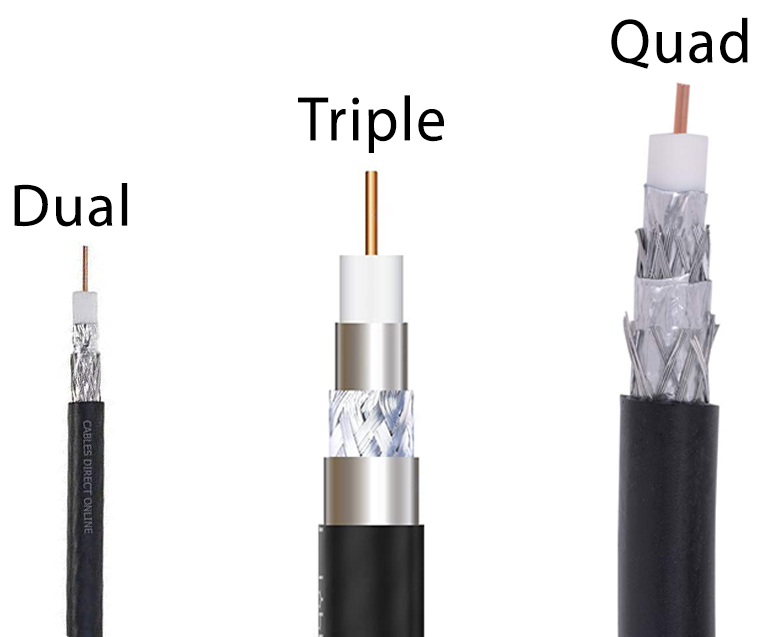
What to Look For When Buying An RG6 Coaxial Cable?
Choosing a decent coax is not rocket science. However, it might be harder for a total beginner to understand all of the markings and simply differentiate a good quality coax from a bad one. And sometimes, the only way to tell if a certain coax is good enough for a particular use case is to have your hands on it and try it.
Here are some most important things to pay attention to when choosing your RG6 coax.
Dual Shield, Triple Shield, or Quad Shield RG6 Coax?
Shielding is one of the most important features of coaxial cables. Therefore, the quality of the signal going through your coax depends on the quality of the shielding.
If you don’t plan to have longer runs (up to 20 feet), even a simple dual shielded RG6 coax will do well. However, the price difference between the dual shielded and triple or quad shielded cables is almost insignificant. Therefore, you will hardly go wrong if you decide to have a quad shielded one.
If you plan to have longer runs, then using a quad-shielded RG6 coax would be best.
Solid Copper or Copper-Clad Steel Core?
Most currently available coaxial cables come with either a copper-clad steel or solid copper conducting core.
A coax with copper-clad steel conducting core relies on the “skinning effect,” which allows signals to travel through the copper coating of the core. At the same time, a solid copper core is fully conductive.
Both of these cables will perform similarly well when it comes to transferring signals. Regardless of the fact that within a copper-clad steel coax, signals travel just through the copper coating, the difference in the signal quality between these two is almost non-existent.
However, if you need to use amplifiers in your coax installation or in any other case where a certain voltage needs to be delivered through the cable, copper-clad steel cables might perform worse than solid copper.
Therefore, if you plan to use some amplifiers in your installation, then you should make sure to use a solid copper core RG6.
Outdoor or Indoor Use?
Not all RG6 coaxial cables are designed for outdoor use. Even though the cable is fully insulated with a PVC jacket, moisture and exposure to sunlight can still affect those cables that are not rated for this kind of use. Therefore you need to pay attention to this if you plan to do outdoor runs.
Even though RG11 is considered more suitable for outdoor use, there are high-quality RG6 coaxial cables that are fully weatherproof, outdoor-rated, and equipped with sealed connectors.
Also, if you need to follow a specific fire code (this is usually the case for commercial installations), you might want to make sure whether you need a riser or plenum-rated coax.
RouterCtrl.com is reader supported. If you buy something using the links on our site, we may earn a small commission.
What are the Best RG6 Coaxial Cables To Buy Right Now?
1. Best RG6 Coax Cable For Gaming and Streaming – Ultra Clarity Coax Cable
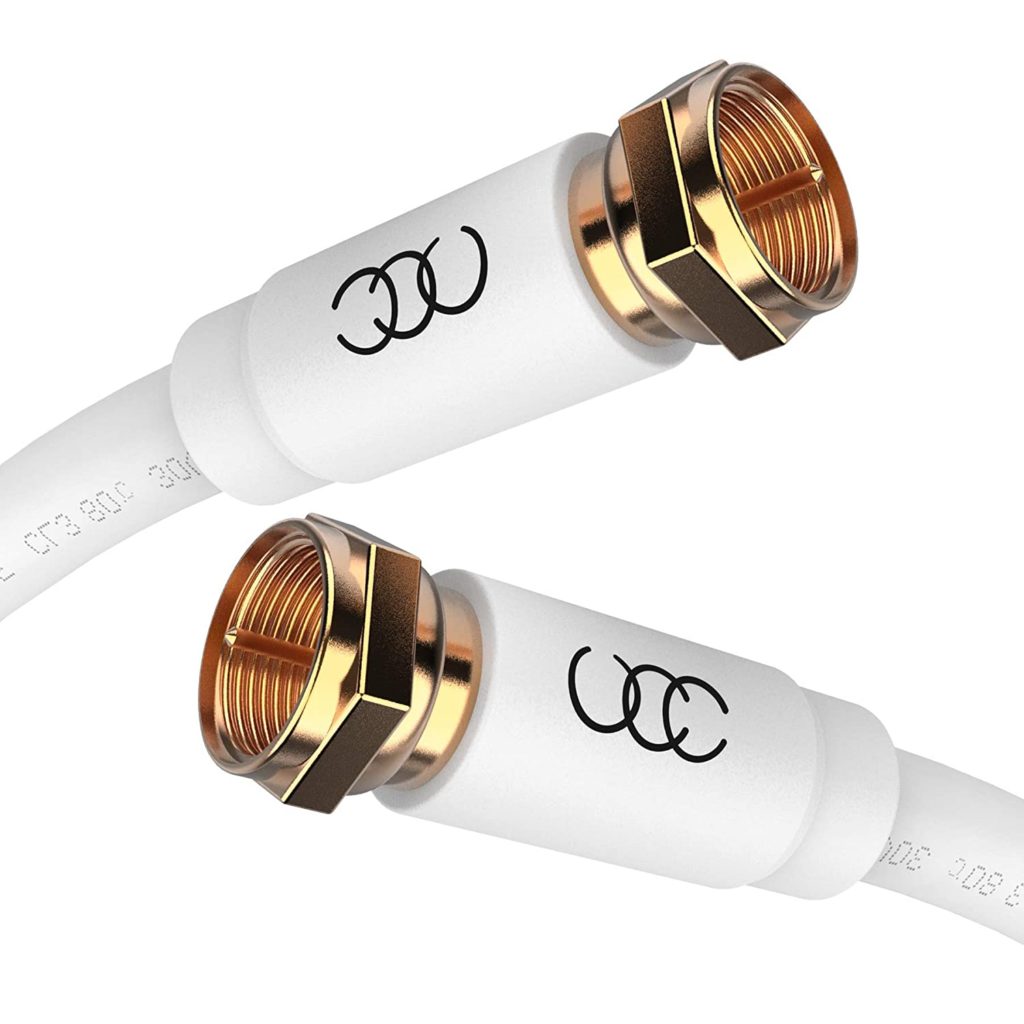
If you are looking for a well-shielded, high-quality RG6 coax, this one made by Ultra Clarity Cables should be a good choice.
It’s a triple shielded cable with high-quality shielding and good quality dielectric insulator. The conducting core is solid copper and is suitable for use with amplifiers. It also comes with gold-plated F-type connectors, which will minimize any signal losses at the connection points.
You can use it for outdoor and indoor installations, and it is also rated for in-wall installations.
This cable will perform very well in Ethernet over coax setups where a high-speed connection is required, making it a good choice for high-speed internet, gaming, and streaming.
2. Best RG6 Coax For Regular Home Use – PHAT SATELLITE INTL

This quad shield solid copper core RG6 coax will give you decent performance for the price.
The four layers of shielding make this cable suitable even for longer runs.
This cable can be used for indoor and outdoor installations, and it comes with a UV-resistant PVC jacket and sealed F-type connectors.
It is perfect for multipurpose use. It will work well with most of the TV and satellite antennas as well.
In case you need to use it with amplifiers, this cable has a solid copper core. Therefore, it is suitable for that kind of use.
3. Best RG6 Coax Rated For Outdoor Use – CIMPLE CO Coax Cable

If you need to run your cable outdoors and/or bury it directly into the ground, this Cimple Co’s RG6 coax should be a great choice.
It features a thick orange PVC jacket, rubber weather boots, fully sealed anti-corrosion F-connectors, and a gel-coated braided shield to protect the cable from various weather conditions and moisture.
This is a solid copper core, dual shield cable with 60% braided aluminum-magnesium shielding and 118% foil overlap.
Regardless of the fact this is a dual-shield cable, it should still yield a decent performance even when used for longer runs.
FAQ
Q: Why is RG6 coax so popular?
A: RG6 is a 75-ohm cable that works well with most TV and internet devices. It works well for home installations and can carry cable/satellite TV and internet signals. The conducting core is thicker than in RG59 and thinner than in RG11; therefore, this cable offers good-quality signal transmission while being flexible enough and easy to handle for in-wall installations.
Q: Will RG6 coaxial cable work with MoCA adapters?
A: MoCA adapters are designed to work with 75-ohm cables. Therefore, RG6 coaxial cables are ideal for MoCA adapters, i.e., when you want to use the same wiring for the internet and TV.
Q: Which connector is used on RG6 coaxial cables?
A: RG6 coaxial cables usually work with “regular” F-type connectors.
Q: What is the max length of an RG6 coaxial cable?
A: RG6 coaxial cables are expected to work well for runs up to 180 feet for cable and satellite TV and the internet. If you, however, plan to use your coax just for an OTA antenna receiving VHF and UHF signals, a well-shielded RG6 coax would work well even with runs longer than 180 feet.
Q: Is RG6 better than RG59?
A: The only use case where RG6 would not be better than RG59 is when you work with 50 MHz and lower signal frequencies.
Q: Is RG6 better than RG11?
A: RG11 has a thicker core and can be used for really long runs (over 300 feet); however, its thickness makes it harder to work with. While RG11 is technically better than RG6, the latter is still more suitable for regular home installations.

Hey, I’m Jeremy Clifford. I hold a bachelor’s degree in information systems, and I’m a certified network specialist. I worked for several internet providers in LA, San Francisco, Sacramento, and Seattle over the past 21 years.
I worked as a customer service operator, field technician, network engineer, and network specialist. During my career in networking, I’ve come across numerous modems, gateways, routers, and other networking hardware. I’ve installed network equipment, fixed it, designed and administrated networks, etc.
Networking is my passion, and I’m eager to share everything I know with you. On this website, you can read my modem and router reviews, as well as various how-to guides designed to help you solve your network problems. I want to liberate you from the fear that most users feel when they have to deal with modem and router settings.
My favorite free-time activities are gaming, movie-watching, and cooking. I also enjoy fishing, although I’m not good at it. What I’m good at is annoying David when we are fishing together. Apparently, you’re not supposed to talk or laugh while fishing – it scares the fishes.

